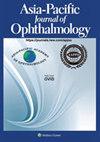Outdoor activity during class recess prevents myopia onset and shift in premyopic children: Subgroup analysis in the recess outside classroom study
IF 4.5
3区 医学
Q1 OPHTHALMOLOGY
引用次数: 0
Abstract
Purpose
To investigate whether premyopia is a risk factor for myopia onset and whether outdoor activities can protect against myopia development in premyopic children in the Recess Outside Classroom (ROC) study.
Methods
Nonmyopic schoolchildren aged 7–11 years were recruited from two schools in Taiwan. One school implemented the ROC program, which encouraged children to go outdoors during recess. The control school maintained its usual schedule. A cycloplegic autorefraction was performed. Premyopia was defined as spherical equivalent refraction ≤ +0.75 diopters (D) and > –0.50 D.
Results
After one year of follow-up, multivariate logistic analysis revealed that the ROC program reduced the risk of myopia onset by 61 % (odds ratio [OR] = 0.39, 95 % confidence interval [CI]: 0.21–0.70, P = 0.002). However, premyopia status increased the risk of myopia onset by 14 times compared to hyperopic status (OR = 14.0, 95 % CI: 1.86–105.3, P = 0.010). In the subgroup analysis of premyopic children, the myopic shift was also significantly lower in the ROC group than in the control group (–0.20 ± 0.60 D/year vs. –0.40 ± 0.66 D/year, P = 0.017). Myopia incidence in premyopic children was significantly lower in the ROC group than in the control group (19.6 % vs. 37.8 %, P = 0.001). Multivariate regression analysis showed that participation in the ROC program was significantly associated with a lower myopic shift in premyopic children (–0.22 D/year, 95 % CI: –0.39 to –0.06, P = 0.008)
Conclusions
Premyopia is a risk factor for myopia onset. A school policy that includes more outdoor time can effectively prevent myopia onset and shift in premyopic children.
课间休息时的户外活动可以预防近视儿童的近视发生和转移:课间休息研究的亚组分析
目的:通过课间休息(Recess Outside Classroom, ROC)研究,探讨近视前期是否为近视发生的危险因素,以及户外活动是否能预防近视儿童的近视发展。方法:选取台湾两所学校7 ~ 11岁非近视学童为研究对象。一所学校实施ROC计划,鼓励孩子们在课间休息时到户外活动。对照学校维持着常规的课程表。进行了睫状体麻痹性自屈光。预近视定义为球面等效屈光度≤+0.75屈光度(D)和> -0.50 D。结果:随访1年后,多因素logistic分析显示,ROC方案使近视发生风险降低61%(优势比[OR] = 0.39, 95%可信区间[CI]: 0.21-0.70, P = 0.002)。然而,与远视状态相比,近视前状态使近视发生的风险增加14倍(OR = 14.0, 95% CI: 1.86-105.3, P = 0.010)。在近视前儿童的亚组分析中,ROC组的近视偏移量也显著低于对照组(-0.20±0.60 D/年vs -0.40±0.66 D/年,P = 0.017)。ROC组近视前儿童的近视发生率显著低于对照组(19.6%比37.8%,P = 0.001)。多因素回归分析显示,参加ROC方案与近视前儿童近视偏移量降低显著相关(-0.22 D/年,95% CI: -0.39 ~ -0.06, P = 0.008)。一项包括更多户外时间的学校政策可以有效地预防近视儿童的近视发生和转移。
本文章由计算机程序翻译,如有差异,请以英文原文为准。
求助全文
约1分钟内获得全文
求助全文
来源期刊

Asia-Pacific Journal of Ophthalmology
OPHTHALMOLOGY-
CiteScore
8.10
自引率
18.20%
发文量
197
审稿时长
6 weeks
期刊介绍:
The Asia-Pacific Journal of Ophthalmology, a bimonthly, peer-reviewed online scientific publication, is an official publication of the Asia-Pacific Academy of Ophthalmology (APAO), a supranational organization which is committed to research, training, learning, publication and knowledge and skill transfers in ophthalmology and visual sciences. The Asia-Pacific Journal of Ophthalmology welcomes review articles on currently hot topics, original, previously unpublished manuscripts describing clinical investigations, clinical observations and clinically relevant laboratory investigations, as well as .perspectives containing personal viewpoints on topics with broad interests. Editorials are published by invitation only. Case reports are generally not considered. The Asia-Pacific Journal of Ophthalmology covers 16 subspecialties and is freely circulated among individual members of the APAO’s member societies, which amounts to a potential readership of over 50,000.
 求助内容:
求助内容: 应助结果提醒方式:
应助结果提醒方式:


